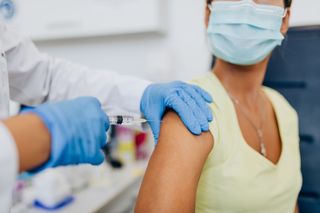Flu season may be very mild this year, thanks to COVID-19 precautions
But you should still get a flu shot.

Flu season may be pretty mild this year thanks to measures taken to stop the spread of COVID-19, according to a new report from the Centers for Disease Control and Prevention (CDC).
In the report, published Thursday (Sept. 17) in the CDC journal Morbidity and Mortality Weekly Report, the researchers note that flu activity in the U.S. right now is at "historical lows," and that data from the Southern Hemisphere — which has just gone through its winter — showed "virtually no influenza circulation."
However, nothing is certain when it comes to the flu season, especially during the middle of a pandemic. So it's still important to prepare for both flu and COVID-19 this fall and winter, and to get a flu shot, the report says.
Related: 14 coronavirus myths busted by science
Flu activity in the U.S. dropped sharply in March, when it became apparent that COVID-19 was circulating widely across the country. This drop likely includes a real decline in flu activity — a side effect of school closures, stay-at-home orders, social distancing and mask-wearing that aimed to slow the spread of COVID-19 — as well as less reporting, as fewer people went to their doctor when they had flu-like symptoms.
Overall, the number of samples that U.S. labs submitted for flu tests (an indicator of flu activity) dropped 61%, from nearly 50,000 per week from September 2019 through February 2020, to 19,500 per week from March through May of this year. Even more striking, there was a 98% drop in the number of samples that tested positive for flu during this time, from 19% to 0.3%.
This summer, flu activity has remained extremely low, with just 0.2% of samples testing positive from May through August, compared with 2.35% during that same period in 2019, 1.04% in 2018 and 2.36% in 2017, the report said.
Sign up for the Live Science daily newsletter now
Get the world’s most fascinating discoveries delivered straight to your inbox.
There's been very little flu activity in the Southern Hemisphere as well. From April through July (during the Southern Hemisphere's fall and winter, or peak flu season), there were only 51 positive flu tests out of more than 83,000 people tested in Australia, Chile and South Africa, for a positivity rate of 0.06%. In contrast, during April through July in the years 2017 to 2019, nearly 14%, or 24,000 out of 178,000 people, tested positive for flu in those three countries.
Initially, declines in flu activity were mostly attributed to doctors testing for COVID-19 rather than the flu. But even when public health officials made renewed efforts to test for flu (and conducted an adequate number of flu tests), there was still "little to no influenza virus" detected, the report said.
The findings suggest that "community mitigation strategies implemented to prevent the spread of COVID-19 … appear to have substantially reduced transmission of influenza in all these countries," the report said.
If these strategies continue through the fall "influenza activity in the United States might remain low and the season might be blunted or delayed," the authors wrote.
But given that people may not necessarily stick with measures meant to slow the spread of COVID-19, it is important to plan for flu this fall and winter. COVID-19 has made getting a flu shot this year "especially important," not only to reduce the risk of flu, but also to reduce the burden on the health care system responding to COVID-19, the CDC says.
The findings also suggest that, in the future, officials might consider implementing some of the COVID-19 mitigation measures during seasons with high flu activity, particularly among those at highest risk for flu complications.
Originally published on Live Science.

Rachael is a Live Science contributor, and was a former channel editor and senior writer for Live Science between 2010 and 2022. She has a master's degree in journalism from New York University's Science, Health and Environmental Reporting Program. She also holds a B.S. in molecular biology and an M.S. in biology from the University of California, San Diego. Her work has appeared in Scienceline, The Washington Post and Scientific American.
Most Popular

